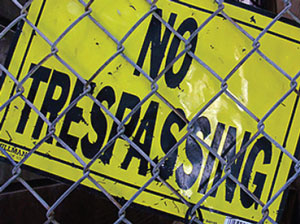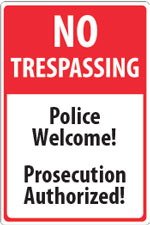
A Trespass Letter of Consent lets the police act for you if someone is on your private property without permission. With this letter, police don’t have to call you first before asking the person to leave or making them leave.
Normally, police can’t remove someone from private property unless the owner says it’s okay. If the owner isn’t there or can’t be reached—especially late at night—this can be a problem.
This letter helps by giving police permission ahead of time. That way, they can act right away if someone is trespassing, even when you’re not available.
How do I put a letter on file?
If a Trespass Letter of Consent would be helpful to you, complete the online form below.
In addition to your consent letter, your property must be posted with ‘No Trespassing’ signs. Signs may include the Trespass authority under ORS 164.245 (property) or ORS 164.255 (building/dwelling). These signs should not include any language specific to loitering.
What happens next?
Should an officer respond to your property, the trespass file is available for officers to quickly determine if there is a current letter on file. The officer can then take appropriate action.
What happens if police arrest someone based on my signed letter?
 In some cases, officers are able to resolve trespass complaints without arresting the involved person. However, there are situations where the officer has no choice but to cite or arrest an offender. In those instances, you will be expected to be available for any resulting court action.
In some cases, officers are able to resolve trespass complaints without arresting the involved person. However, there are situations where the officer has no choice but to cite or arrest an offender. In those instances, you will be expected to be available for any resulting court action.
What if my property is a multi-dwelling complex?
 A trespass letter is generally ineffective for multi-dwelling complexes. A resident may “invite” whomever they choose to visit them at their residence; however, land-lords/property managers are encouraged to post all of their property entrances with signs that identify who may be on their property; e.g. “No Trespassing except tenants and invited guests. Police welcome.”
A trespass letter is generally ineffective for multi-dwelling complexes. A resident may “invite” whomever they choose to visit them at their residence; however, land-lords/property managers are encouraged to post all of their property entrances with signs that identify who may be on their property; e.g. “No Trespassing except tenants and invited guests. Police welcome.”
What happens if I change my mind or sell my property?
If the status of your property changes in any way, we ask that you notify us in writing of your desire to terminate the trespass letter. This termination notice can be faxed to 541-928-6692 or delivered/mailed to:
Community Resource Unit Supervisor
Albany Police Department
2600 Pacific Boulevard SW
Albany, OR 97321
What is the law regarding trespass?
Generally, a person commits the offense of Criminal Trespass if the person enters or remains unlawfully in or upon premises when such premises are not open to the public; or the person fails to leave premises that are open to the public after being lawfully directed to do so by the person in charge. Refer to Oregon Revised Statutes (ORS) 164.245 and 164.255.
Oregon Revised Code (ORS) 164.245 & 164.255
164.245 Criminal trespass in the second degree.
(1) A person commits the crime of criminal trespass in the second degree if the person enters or remains unlawfully in a motor vehicle or in or upon premises.
164.255 Criminal trespass in the first degree.
(1) A person commits the crime of criminal trespass in the first degree if the person:
(a) Enters or remains unlawfully in a dwelling;
(b) Having been denied future entry to a building pursuant to a merchant’s notice of trespass, reenters the building during hours when the building is open to the public with the intent to commit theft therein;
(c) Enters or remains unlawfully upon railroad yards, tracks, bridges or rights of way; or
(d) Enters or remains unlawfully in or upon premises that have been determined to be not fit for use under ORS 453.855 to 453.912.
(2) Subsection (1)(d) of this section does not apply to the owner of record of the premises if:
(a) The owner notifies the law enforcement agency having jurisdiction over the premises that the owner intends to enter the premises;
(b) The owner enters or remains on the premises for the purpose of inspecting or decontaminating the premises or lawfully removing items from the premises; and
(c) The owner has not been arrested for, charged with or convicted of a criminal offense that contributed to the determination that the premises are not fit for use.
Definitions: As used for ORS 164.205 to 164.270
(A) “Open to the public” means premises which by their physical nature, function, custom, usage, notice or lack thereof or other circumstances at the time would cause a reasonable person to believe that no permission to enter or remain is required.
(B) “Person in charge” means a person, a representative or employee of the person who has lawful control of premises by ownership, tenancy, official position or other legal relationship. “Person in charge”includes, but is not limited to the person, or holder of a position, designated as the person or position-holder in charge by the Governor, board, commission or governing body of any political subdivision of this state.
(C) “Premises” includes any building and any real property, whether privately or publicly owned.
How can I minimize property damage and theft?
- Post “No Trespassing” signage
- Install motion-activated lighting
- Provide on-site supervision
- Install video surveillance
- Maintain property with low or no brush/tall grass
- Install locks/gates/fences
- Join our Neighborhood Watch Program
- Repair damage and graffiti immediately
- Details
Caring for Your Children
Code Enforcement
Graffiti Removal
Home Security Survey
Home Security System Alarm Permits
Neighborhood Watch Program
National Night Out
APD Drug Drop-Box
Programs for Schools
Programs for Seniors
Protecting Your Vehicle
Vehicles Parked Illegally or Abandoned
Bike Helmet Law
Motorized Scooters
Pedestrian Safety Enforcement
Seat Belt Law
- Details
National Night Out celebrates our Police-Community Partnerships. Albany Police Department's commitment to community policing must include you, the community. National Night Out is held annually on the first Tuesday in August. This year's events are scheduled for August 4, 2026 from 5:30 until 8:00 p.m.
Residents of Albany are asked to lock their doors, turn on outside lights and spend the evening outside with neighbors. Neighbor knowing neighbor is one of the most effective ways to prevent crime. Local law enforcement and Albany Fire Department will briefly visit with residents of many of the neighborhoods registered.
- Details
Crime Prevention Through Environmental Design (CPTED) studies ways to design physical spaces to reduce undesirable behavior and crime through focus on:
- A Physical Environment: This could be a building, a park, an office, a street, etc.
- Resulting Behavior of People: Some locations seem to inspire rowdy behavior; other locations encourage calmer behavior.
- Using Space More Effectively: How can the space be redesigned to encourage desirable behaviors and discourage undesirable behaviors?
- Crime/Loss Prevention: These tend to be byproducts of the redesign, rather than primary targets.
For more information, contact:
Kris Schendel
541-917-7680
Positive |
Negative |
|---|---|
|
The fencing defines the site, thereby controlling access to the property. It also allows for strong natural surveillance. |
Trees with low limbs and tall shrubbery create hidden spaces. Trim trees up to 6 feet and shrubs down to 2 feet to create good visibility on a property. |
|
The managers of this convenience store maintain natural surveillance by keeping the windows clear of posters and ads. |
A would-be criminal may see this store as an easy one to rob because ads in the windows almost completely obscure the view inside. |
|
A potential criminal is less likely to attempt a crime if he or she is at risk of being observed. |
Little or no maintenance is taking place on this property, creating an image or sense that a person can do anything here and get away with it. |
|
A good example of Territorial Reinforcement through the use of lighting. |

- Details
Trespass Letter of Consent
A Trespass Letter of Consent is a document that allows a police officer to immediately act on your behalf, and take enforcement action against a person trespassing on your private property without first contacting you.
Police officers do not normally have the authority to go onto private property, which is not open to the public, and remove individuals or direct them to leave without the consent or authority of the person legally responsible for the property.
A Trespass Letter of Consent can be entered for a:
Graffiti Removal
People create graffiti for a variety of reasons. Graffiti can be a random act of vandalism or deliberate communication between gang members. Regardless of the reason, it is important to remove graffiti as soon as it appears. Graffiti that is allowed to remain on any surface attracts more graffiti, causing the area to appear run down.
The purpose of the Graffiti Removal program is to assist and educate businesses or property owners about the removal of graffiti in a timely manner. Participating organizations encourage citizens to report the presence of graffiti and expedite its removal.
If you are a victim of graffiti in the Albany area, please call the Albany Police Department 541-917-7680.
Educational programs from APD
For additional information about these programs, contact:
Crime Prevention Specialist Laura Hawkins
541-917-3206
Burglary Prevention
A burglary is when someone breaks into your building and usually steals something from inside, but they do not use a threat or force against a person while doing so. In most cases, the burglar is never seen.
Burglary is not the same as robbery.
Robbery Prevention
A robbery is when the criminal uses force or a threat against a person during the commission of the crime. The prevention/safety tips for these two types of crimes are different. The Community Education Specialist can assist you with a Crime Prevention Through Environmental Design survey.
Rental Property Program
This program is for rental property owners and managers. This program was developed to assist owners/managers of rental properties with problem tenants, aid in making managers more aware of activity on or around their properties, reduce police calls for service to certain locations and build a stronger relationship between law enforcement and the rental community.
Shoplifting
APD has created a helpful shoplifting manual to assist businesses with information about shoplifting enforcement and prevention.
- Details










